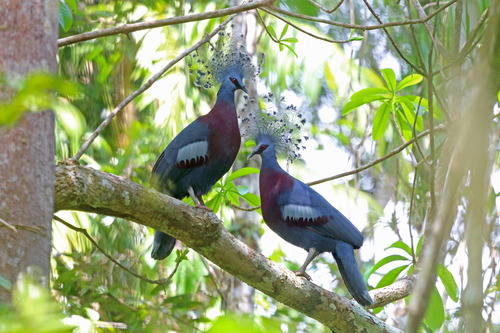
Victoria Crowned Pigeon
The Victoria Crowned Pigeon (*Goura victoria*) is a large, terrestrial pigeon native to the northern parts of New Guinea and surrounding islands. It is renowned for its spectacular, elaborate, lace-like crest of feathers, which gives the bird its regal name, honoring Queen Victoria. This species plays a crucial role in its forest ecosystem as a seed disperser. Beyond its striking appearance, the Victoria Crowned Pigeon is culturally significant to some indigenous communities in New Guinea, often featuring in traditional ceremonies and folklore.
73-78 cm
Length
Unknown cm
Wingspan
Near Threatened
Conservation Status
Distribution
The Victoria Crowned Pigeon is found in northern New Guinea and the surrounding islands, including Yapen, Biak, and Salawati. It is primarily found in the lowlands and foothills.
Lifespan
Up to 25 years in captivity; lifespan in the wild is not well documented but likely shorter.
Victoria Crowned Pigeon's Habitat
Habitat Types
Lowland rainforests, Swamp forests, Sago palm forests, Sometimes in drier woodland areas
Climate Zones
Tropical
Adaptations
Their strong legs and terrestrial habits are adaptations to foraging on the forest floor. The relatively large body size may be an adaptation to deter some predators.
Variations
There are subtle regional variations in plumage, but no universally recognized subspecies.
Appearance
Breeding Plumage
Plumage is generally consistent year-round.
Seasonal Feather Changes
No significant seasonal variations.
Sex Based Plumage Differences
Males and females have very similar plumage.
Notable Features
Large, elaborate, fan-shaped crest with white tips., Deep blue-grey body plumage., Maroon chest., Red iris.
Diet and Feeding
Primary Foods
Fallen fruits, Seeds, Berries, Occasionally small invertebrates
Foraging Behavior
Forages on the forest floor, picking up fallen fruits and seeds. It may also scratch at the leaf litter to find invertebrates.
Specializations
No highly specialized feeding adaptations; a generalist frugivore and granivore.
Seasonal Diet Variations
Diet likely varies depending on the fruiting seasons of different trees within their range.
Behavior
Social Structure
Usually found in pairs or small family groups.
Communication
Deep, booming calls., Whooping sounds., Visual displays during courtship.
Migration
Non-migratory; generally sedentary within their home range.
Territorial or Group Behaviors
Pairs may defend a territory, especially during the breeding season. They are generally not highly aggressive.
Conservation
Threats
Habitat loss due to logging and agriculture., Hunting for food and feathers., Capture for the pet trade.
Protection Programs
CITES Appendix II (regulates international trade)., Some protected areas within their range.
Local National Laws
Protected under Indonesian law.
Population Trend
Decreasing
Population Estimates
Population estimates are not precise, but the species is considered to be declining.
Interesting Facts
They are the largest surviving species of pigeon in the world.
Their size is comparable to that of a small turkey.
They produce 'crop milk' to feed their young.
This nutritious substance is produced by both male and female pigeons and doves.
The genus name, Goura, comes from a native Papuan name for these pigeons.
This highlights the importance of recognizing indigenous knowledge.
Faqs about Victoria Crowned Pigeon
Can Victoria Crowned Pigeons fly?
Yes, they can fly, but they spend most of their time on the ground. They typically only fly short distances, often to escape danger or to roost in trees.
Are they endangered?
They are classified as Near Threatened by the IUCN. Their populations are declining due to habitat loss and hunting.
What is their lifespan?
They can live for up to 25 years in captivity. Their lifespan in the wild is likely shorter.
Copyright @ Nature Style Limited. All Rights Reserved.
 English
English